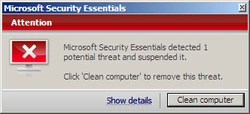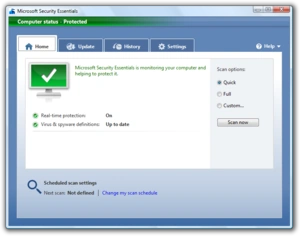| Microsoft Security Essentials | |
|---|---|
| Author |
Microsoft |
| Latest Release |
2009,09,29 |
| OS |
Windows XP SP2 (32-bit) |
| Type | Antivirus |
| License | Freeware, closed source |
| Website | microsoft.com/security_essentials/ |
Microsoft Security Essentials (MSE) (previously codenamed Morro) is a free antivirus software created by Microsoft that provides real-time protection against viruses, spyware, rootkits, trojans and other malicious software for Windows XP, Vista, and 7.[1] MSE replaces Windows Live OneCare (a subscription antivirus service) and Windows Defender, which only protects users from adware and spyware.[2]
This program runs in the background without slowing down the computer. It requires a genuine Windows installed Operating System.[3] It is geared for home use, unlike Microsoft's upcoming enterprise-oriented product Microsoft Forefront.
Symantec and McAfee, two competing antivirus vendors, responded by claiming that MSE is not comparable with their own offerings.[4] AVG Technologies viewed MSE positively, stating it reinforced the company's ideal of free antivirus software. Reviews were mostly positive, citing its organized interface, low resource usage, and free cost.[5]
Development[]
Microsoft announced Morro on November 18, 2008. It marked a change in Microsoft's consumer antivirus marketing strategy. Instead of offering a subscription antivirus with a host of other tools—photo backup, and a firewall—Morro would be free for all genuine installations of Windows and simply offer protection against malware.[6] Microsoft Forefront will be offered alongside Morro, with central management tools not present in Morro. A leak of version 1.0.2140.0 revealed the internal name of Morro was changed to Microsoft Security Essentials.[7]
On June 23, 2009, Microsoft opened a public beta to 75,000 people in the United States, Israel, People's Republic of China and Brazil. At the time, Microsoft stated that MSE would be finalized and released before the end of 2009, in 20 markets and 10 languages.[8]
On September 20, Microsoft e-mailed beta testers that the final version of the product "will be released to the public in the coming weeks."[9] The final 1.0 build was released on September 29, 2009.[10][11] Microsoft is specifically targeting computer users without credit cards, new hardware, and broadband Internet connections.[12]
Hardware requirements are dependent on the operating system. For Windows XP, a processor speed of at least 500 MHz and 1 GB of RAM is required. Under Windows Vista and 7, a one gigahertz processor and 1 GB of RAM is required. Under any compatible operating system, a VGA screen of 800 × 600 or higher, 140 MB of free space, and an Internet connection are also required.[13]
Features[]
MSE is a basic security suite designed for consumers but based on the Forefront Client Security desktop agent, solely providing malware detection and removal, but lacking Forefront Client Security's centralized management features. It includes the same antimalware engine (dubbed "Microsoft Malware Protection Engine", or MSMPENG for short), and virus definitions that all other Microsoft desktop antimalware products share, including Forefront Client Security, Windows Live OneCare, and Windows Defender (Defender excludes the antivirus definitions which are separate from the antispyware definitions). Before installation, MSE checks for a validated copy of Windows. No registration or personal information is required.[14] The program will disable Windows Defender, as it provides protection against malware, not limited to spyware and adware.[2]
Updates are published three times a day to Microsoft Update.[15] Using default settings, archived files are decompressed, and then scanned. File downloads and e-mail attachments are also scanned. Its Dynamic Signature Service attempts to better identify malicious files by checking for updates if an application exhibits suspicious behavior. [16] Before taking action against a suspect file, MSE prompts for user input. If no response is received in ten minutes, then the suspected malware is handled according to its default action, letting MSE determine what to do with the malware. System Restore points are created before removing found malware.[17]
Reception[]
Industry response[]
After Microsoft publicly announced Morro on November 19, 2008, Symantec and McAfee shares fell 9.44 and 6.62 percent respectively. Microsoft shares also fell 6 percent. However, Microsoft claims Morro will not directly compete with other paid-for antivirus software; rather it was "focused on the 50 to 60 percent [of PC users] who don't have, or won't pay for, antivirus protection, antimalware protection," according to Amy Barzdukas.[18]
Symantec, McAfee, and Kaspersky Lab representatives dismissed Morro as a competitor. Tom Powledge of Symantec claimed OneCare offered "substandard protection" and an "inferior user experience", implying Morro would be the same. McAfee stated "With OneCare's market share of less than 2%, we understand Microsoft's decision to shift attention to their core business." Justin Priestley of Kaspersky stated, "[Microsoft] continued to hold a very low market share in the consumer market, and we don't expect the exit of OneCare to change the playing field drastically."[19]
An AVG Technologies representative stated, "We view this as a positive step for the AV landscape. AVG has believed in the right to free antivirus software for the past eight years." Nevertheless, AVG raised the issue of distributing the software, "Microsoft will have to do more than simply make the product available."[19] Bundling Morro with Windows would likely cause antitrust lawsuits.[20][21]
After a Microsoft spokesman stated on June 10, 2009, that a beta version of Morro would soon be released, Microsoft shares were up 2.1 percent. Both Symantec and McAfee shares fell 0.5 percent and 1.3 percent respectively. Daniel Ives, an analyst with FBR Capital Markets, stated Morro would be a "long-term competitive threat", though near-term impact would be negligible.[1]
OPSWAT, a software development and service company, announced that from March 23, 2011 to February 15, 2012, Microsoft Security Essentials has grown to become more popular among American PC owners with a 14.58 percent market share [22].
Reviews[]

A pop-up notification stating malware was found.
Reviews of the public beta were mostly positive, citing its low resource usage, straightforward user interface, and price point.[23][24][25] Brian Krebs of The Washington Post found MSE used 4 megabytes of RAM during testing, even during scans. A "quick scan" took about 10 minutes, and a "full scan" about 45 minutes on an installation of Windows 7.[25]
PCWorld noted its "clear-cut" and "cleanly designed" tabbed user interface. At the top of the main tab, the security status is clearly shown. The other three tabs allow users to manually update MSE, review its history, and change program settings. However, PCWorld found some of the settings to be cryptic and confusing. Settings, such as what to do when malware is found, default to "Microsoft Security Essentials' recommended action". There is no explanation of the recommended action except in the help file. The editor was also confused because MSE does not mention it automatically updates itself within the interface; some may believe they must manually update MSE through the "Update" tab.[24]
PC Magazine cited MSE's small installation package (about 7 MB, depending on the operating system) and its speedy installation. On the downside, the full installation occupied about 110 MB of disk space, and the initial update took 5 to 15 minutes. The editor also noted the fact MSE sets Windows Update into its fully automatic mode, which automatically downloads and installs updates although it can then be turned off again through the control panel. Installation succeeded on 12 malware-infected systems. Some full scans took over an hour on infected systems; however, a scan on a clean system took 35 minutes.
During an on-demand scan, MSE found 89 percent of malware samples; but only 30 percent of commercial keyloggers. Those results were average, according to the editor. MSE found 67 percent of rootkits. The suite detected half of the editor's scareware samples. The suite's real-time protection found 83 percent of malware and blocked the majority of them. In this test, 40 percent of the commercial keyloggers were found. MSE found 78 percent of the rootkits. The editor expressed optimism MSE would improve during its beta testing period.[23]
See also[]
- Microsoft Anti-Virus (MSAV), antivirus for MS-DOS (1993–1996)
References[]
- ↑ 1.0 1.1 Finkle, Jim. "Update 3-Microsoft will soon unveil free anti-virus software", Thomson Reuters, June 10, 2009, accessed July 4, 2009.
- ↑ 2.0 2.1 Thurrott, Paul. "Microsoft Security Essentials Public Beta", Paul Thurrott's SuperSite for Windows, June 18, 2009, accessed July 4, 2009.
- ↑ http://www.microsoft.com/security_essentials/
- ↑ Keizer, Gregg. "Rivals mock Microsoft's free security software" Computerworld, September 29, 2009, accessed September 30, 2009.
- ↑ Protalinski, Emil. "First look: Microsoft Security Essentials impresses", Ars Technica, September 29, 2009, accessed September 30, 2009.
- ↑ "Microsoft to offer free security", BBC News, November 19, 2008, accessed July 4, 2009.
- ↑ Protalinski, Emil. "Leaked: Microsoft Security Essentials (codename Morro)", Ars Technica, June 17, 2009, accessed July 19, 2009.
- ↑ Foley, Mary-Jo"Microsoft Security Essentials beta to be capped at 75,000, kicks off today", ZDNet, June 23rd, 2009, accessed September 29, 2009.
- ↑ Emil Protalinski "Microsoft Security Essentials release in the coming weeks" Ars Technica September 21, 2009 accessed September 21st, 2009.
- ↑ Mediati, Nick"Microsoft Security Essentials Launches Tuesday" PCWorld, June 28, 2009, accessed September 29, 2009.
- ↑ "Microsoft Launches New Anti-Malware Service" Computer Business Review
- ↑ Fallon, Sean."Microsoft Security Essentials Antivirus Software (Codename: Morro) Available on June 23rd", Gizmodo, June 18, 2009, accessed July 6, 2009.
- ↑ Microsoft "Find out what you need to know about installing and running Microsoft Security Essentials. ", accessed September 29, 2009.
- ↑ Bott, Ed. "How good is Microsoft's free antivirus software?", ZDnet, June 18, 2009, accessed July 6, 2009.
- ↑ Mills, Elinor. "Microsoft's free antimalware beta on the way", CNET, June 18, 2009, accessed July 10, 2009.
- ↑ Hoffman, Stefanie. "Microsoft Security Essentials Beta Reaches Max Downloads", ChannelWeb, June 24, 2009, accessed July 19, 2009.
- ↑ Krebs, Brian. "Microsoft Debuts Free Antivirus Software Beta", The Washington Post, June 24, 2009, accessed July 10, 2009.
- ↑ Hoffman, Stefanie."Microsoft: Morro Won't Compete With Symantec, McAfee", ChannelWeb, November 19, 2008, accessed July 4, 2009.
- ↑ 19.0 19.1 Vamosi, Robert. "Antivirus firms shrug at Microsoft's free security suite", CNET, November 19, 2008, accessed July 6, 2009.
- ↑ Fried, Ina. "Will Microsoft's antivirus move draw antitrust fire?", CNET, November 18, 2008, accessed July 6, 2009.
- ↑ Schofield, Jack. "Waiting for Morro: Microsoft's free anti-virus software", guardian.co.uk, June 11, 2009, accessed July 6, 2009.
- ↑ "Microsoft Security Essentials gaining popularity" PanArmenian, March 17, 2012, accessed July 16, 2012
- ↑ 23.0 23.1 Rubenking, Neil J. "Microsoft Security Essentials beta", PC Magazine, June 18, 2009, accessed July 10, 2009
- ↑ 24.0 24.1 Mediati, Nick. "Microsoft Security Essentials: Basic, Automatic Protection", PCWorld, June 24, 2009, accessed July 10, 2009.
- ↑ 25.0 25.1 Krebs, Brian."Microsoft Debuts Free Antivirus Software Beta", The Washington Post, June 24, 2009, accessed July 10, 2009.
